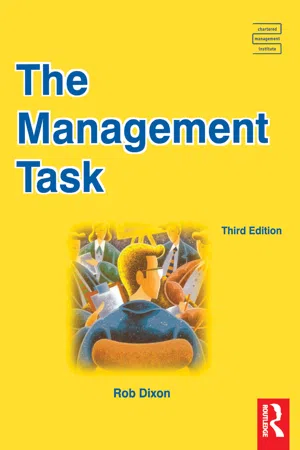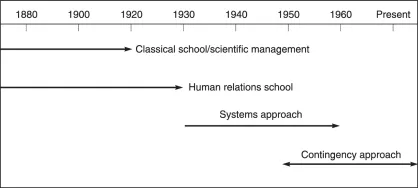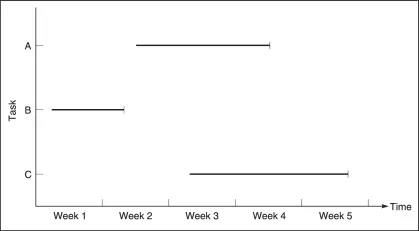
This is a test
- 304 pages
- English
- ePUB (mobile friendly)
- Available on iOS & Android
eBook - ePub
The Management Task
Book details
Book preview
Table of contents
Citations
About This Book
This is a third edition of the Management Task, a diploma level book in the Chartered Management of Institute series.This book addresses the task of management in terms of the different processes involved, for example, planning, decision-making, organizing, communication, and the more specific management functions such as personnel, marketing and the environment of management and business. It covers the knowledge and understanding required as part of any competency-based management programme.This new edition has nearly doubled in length to cover the new areas of the CMI diploma syllabus and now includes two new sections on marketing and new management thinking.
Frequently asked questions
At the moment all of our mobile-responsive ePub books are available to download via the app. Most of our PDFs are also available to download and we're working on making the final remaining ones downloadable now. Learn more here.
Both plans give you full access to the library and all of Perlego’s features. The only differences are the price and subscription period: With the annual plan you’ll save around 30% compared to 12 months on the monthly plan.
We are an online textbook subscription service, where you can get access to an entire online library for less than the price of a single book per month. With over 1 million books across 1000+ topics, we’ve got you covered! Learn more here.
Look out for the read-aloud symbol on your next book to see if you can listen to it. The read-aloud tool reads text aloud for you, highlighting the text as it is being read. You can pause it, speed it up and slow it down. Learn more here.
Yes, you can access The Management Task by Rob Dixon in PDF and/or ePUB format, as well as other popular books in Negocios y empresa & Negocios en general. We have over one million books available in our catalogue for you to explore.
Information
Part One
Introduction
C H A P T E R 1
Introduction
What is ‘The Management Task’?
The task of management is all about organizing groups of people to work together productively towards known, clear goals, or objectives. There are many different levels of management, from production foremen, hospital ward sisters and senior secretaries, all supervising small groups of employees, to managing directors and chief executives, responsible for directing large multinational companies and organizations. However, the basic description of the management task holds good for all managers, regardless of their seniority.
Unfortunately, management is not quite as simple as that! The manager’s job is very wide ranging. Mintzberg (1973) analysed the roles managers have to adopt during their work and listed seven major ones, as follows:
1 The entrepreneur: the manager as planner and risk-taker.
2 The resource allocator: the manager as organizer and coordinator.
3 The figurehead/leader: the manager as motivator and coordinator.
4 The liaisor/disseminator: the manager as coordinator and communicator.
5 The monitor: the manager as controller.
6 The spokesperson/negotiator: the manager as motivator and communicator.
7 The disturbance-handler: the manager as motivator and coordinator.
Thus we can see that the manager’s job is to plan, take decisions, motivate, lead and organize the employees that he/she is responsible for, communicate with them and control and coordinate their work. In Part Two these management processes of planning, motivating, etc., will each be looked at in detail.
Why Management is Important
Good management is vital if a business or any other enterprise is to be successful. Drucker (1967) regards an effective management team as the one big advantage a company can have over its competitors:
In a competitive economy, above all, the quality and performance of the managers determine the success of a business, indeed they determine its survival. For the quality and performance of its managers is the only effective advantage an enterprise in a competitive economy can have.
Effective management can transform an inefficient, underperforming organization into a profitable, sound business, but the reverse is also true. Ineffectual managers can ruin sound businesses by allowing them to stagnate, content to rely on past achievements rather than looking for new challenges. No doubt you can think of examples of both kinds of management in companies or just departments that you are familiar with.
The Development of Modern Management Ideas
Before we go on to look at the processes involved in the management task, the rest of this chapter will give a little background information about the changes in management thinking over the years, which should give you an insight into how and why organizations are run in the ways they are today.
It should be remembered that, naturally, each theory reflects the thinking and attitudes of its time. But it is clear that they still have a lot of influence on today’s business methods and ideas.
Theories about the best way to manage people have developed over the years from the beginning of the century. The three main schools of thought are the classical school, the human relations school, and the systems school of management. Figure 1.1 shows how the different theories have developed over time, and have built upon previous ideas.

Figure 1.1
Developments in management theory
The classical school
The classical approach to management concentrated on trying to form general principles of management. These principles, it was hoped, could then be applied to all organizations in every business situation. Techniques of mass-production were just beginning to be widely used, and managers were concerned to find the most economical method of producing the greatest number of goods.
The solution of the classical theorists was to divide work tasks up into their constituent parts. Thus, for example, instead of a cobbler making one complete pair of shoes, from the initial cutting of the leather right through to the final buffing and polishing of the finished article, before starting afresh on a different pair, the jobs would be divided between several workers. One would cut the leather for all the shoes to be made that day, another would stretch the leather, and so on.
The main writers of the classical school were F. W. Taylor, Henri Fayol, Frank and Lillian Gilbreth, and Henry Gantt.
F. W. Taylor and Scientific Management
Taylor (1856-1915), whose ideas were developed when he was a manager at a steel works in the USA, was concerned with the formal structure and activities of organizations, i.e. the optimum numbers of employees that each manager should supervise, work division, etc. Taylor believed in, and pioneered the use of, scientific methods of observation and analysis in management.
The Principles Behind Scientific Management
In Principles of Scientific Management (1911) Taylor set out the fundamental principles which he thought underlay scientific management. These can be summed up as follows:
1 Replacing rules of thumb with a true science of work. Many companies relied (and some still do!) upon information retained in the heads of employees, rather than gathering all that knowledge together and making a proper record of it. Taylor felt that without this reliance upon the ‘it has always been done this way’ mentality, ‘every single subject, large and small, becomes the question for scientific investigation, for reduction to law’ (Taylor, 1911).
2 Replacing ‘chaotic individualism’ with cooperation between managers and employees to the mutual benefit of all.
3 The scientific selection and progressive development of workers, i.e. workers should be given jobs which they are best suited to do, and carefully trained to do these jobs. This would be to the advantage of both companies and employees, allowing both groups to prosper.
4 Working for maximum output rather than restricted output.
Taylor’s aim in his system of scientific management was to increase the efficiency of production methods, not just to lower company costs and thus increase profits, but also to enable the workers to increase their productivity and so earn higher wages. Through scientific methods of job analysis, establishing the best, most efficient way of doing the work, and through training the workers in these efficient production methods, greater productivity could, Taylor believed, be achieved. Scientific management would eliminate the ignorance on the parts of both managers and workers which led to unrealistic production targets and piece-rates of pay, and to inefficient ways of production.
Other classical theorists
Taylor was not the only proponent of scientific management. Other early supporters included Frank and Lillian Gilbreth and Henry Gantt.
The Gilbreths
The Gilbreths’ contribution to scientific management was to develop motion study into a management tool capable of analysing work operations to establish the most efficient way of doing any particular task.
Frank Gilbreth (1917) defined motion study as ‘dividing the work into the most fundamental elements possible; studying these elements separately and in relation to one another; and from these studied elements, when timed, building methods of least waste’.
Motion study was carried out using flow process charts. Symbols were used to analyse the processes of
■ Operation
■ Inspection
■ Storage
■ Transportation
■ Delay
Unlike Taylor, who tended to think of pay as being the only motivator of workers and, therefore, that if workers were paid a fair piece-rate they would increase their productivity in order to maximize their earnings, the Gilbreths recognized that workforce output was dependent upon other factors as well. These included worker fatigue, poor lighting, heating and ventilation. The Gilbreths used motion studies to help reduce fatigue among workers, and they also introduced rest periods and shorter working days.
Henry Gantt
Gantt was one of Taylor’s colleagues. He, too, humanized Taylor’s ideas of scientific management by introducing day-rates of pay (instead of the piece-rate system), with additional bonuses for those workers who exceeded the daily production targets. Foremen were also encouraged to train workers in their jobs by receiving a bonus for every worker who met the production targets.
Gantt is chiefly remembered today for developing a type of bar chart showing the time relationships between the stages in production processes. The Gantt chart (Figure 1.2) was originally designed to show how far a task had been achieved in comparison to the optimum target set.

Figure 1.2
A Gantt chart
Henri Fayol (1841-1925)
Henri Fayol, a French industrialist, did more than anyone to popularize the idea of the ‘universality of management principles’: the concept that, regardless of the sort of business in question, the same broad principles of management apply. While Taylor’s work was concentrated upon the shop-floor, Fayol studied management’s role throughout the organization.
Fayol is known as the ‘father of modern operational management theory’, and, as you will see, his principle...
Table of contents
- Cover
- Half Title
- Title Page
- Copyright
- Contents
- Series adviser’s preface
- Preface
- Part One: Introduction
- Part Two: The Management Processes
- Part Three: Management Functions
- Part Four: The Managerial Environment
- Part Five: New Developments in Management Thinking
- Part Six: Conclusions
- Bibliography
- Index